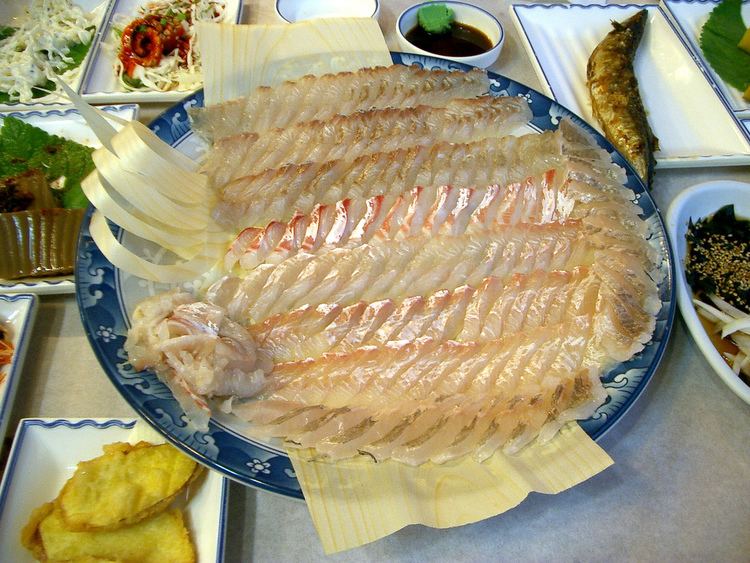Hangul 회 Revised Romanization hoe | Hanja 膾 McCune–Reischauer hoe | |
 | ||
Similar Maeun‑tang, Jjim, Guk, Kimchi, Jorim | ||
Hoe ([hwe̞]) refers to several varieties of raw food dishes in Korean cuisine. Saengseon hoe (생선회) or "Hwareo hoe" (활어회) is thinly sliced raw fish or other raw seafood (similar to Japanese sashimi). Yukhoe (육회) is made of raw beef seasoned with soy sauce, sesame oil, and rice wine, while gan hoe (간회) is raw beef liver with a sauce of sesame oil and salt.
Saengseon hoe is sometimes called sashimi (사시미), a Japanese loanword in use despite efforts to remove loanwords from the Korean language.
Fish hoe is usually dipped in a spicy gochujang-based sauce called chogochujang (초고추장) or Ssamjang (쌈장), and wrapped in lettuce and Korean perilla leaves.
When people finish a meal of saengseon hoe at a restaurant, they sometimes order maeuntang (spicy fish stew, from the fish heads and remaining meat) together with various vegetables.
History
Historians assume the tradition of eating hoe was imported from China to Korea during early in the Three Kingdoms Period (57 BC-668 AD), facilitated by frequent exchanges between China and Korea on the Korean peninsula. According to the Confucian Analects, written in the 1st century BC, Confucius said "Do not shun rice that is well clean; do not shun kuai that is thinly sliced" (食不厭精,膾不厭細). While the term kuai (膾) originally referred to finely sliced raw fish or other meats such as beef or lamb, since the Qing and Han Dynasties it has referred mainly to raw fish.
With the popularization of Buddhism in Korea, beginning in the middle of the Three Kingdoms Period, and running late into the Goryeo Dynasty (918–1392), the consumption of fish and other meat products (including hoe) declined. As the influence of Buddhism waned in the late Goryeo Dynasty period, the consumption of hoe began to lose its stigma.
During the Joseon Dynasty, the state promoted Confucianism, and, as Confucius was known to have enjoyed eating raw meat, hoe consumption greatly increased.
Today, the consumption of raw meat or seafood in Chinese cuisine is rare outside of a few regions, such as Chaozhou where dishes such as yusheng are popular.
